We get acquainted with the tomato "Irishka F1" and try to grow it on our site
For more than a decade, the Irishka hybrid tomato has been conquering the Near Abroad and Russian regions. Outwardly, the fruits are ordinary, characteristic of a tomato shape, but with a unique taste of a real tomato. Many gardeners, having tried exotic tomatoes, return to the usual, all familiar varieties and hybrids. Because they are not only easy to care for, but also have a high content of vitamin C and other substances beneficial to the body. The long life of the hybrid in the tomato world testifies to the reliability of the culture.
Learn how to prepare seeds, grow seedlings and care for the Irishka hybrid on your own plot.
The content of the article
Characteristics and description of the variety
The f1 hybrid was developed by Alexey Alekseevich Mashtakov. It was added to the Russian State Register for the North Caucasus (6) region more than 10 years ago, in 2015. Recommended for outdoor cultivation.
Distinctive features
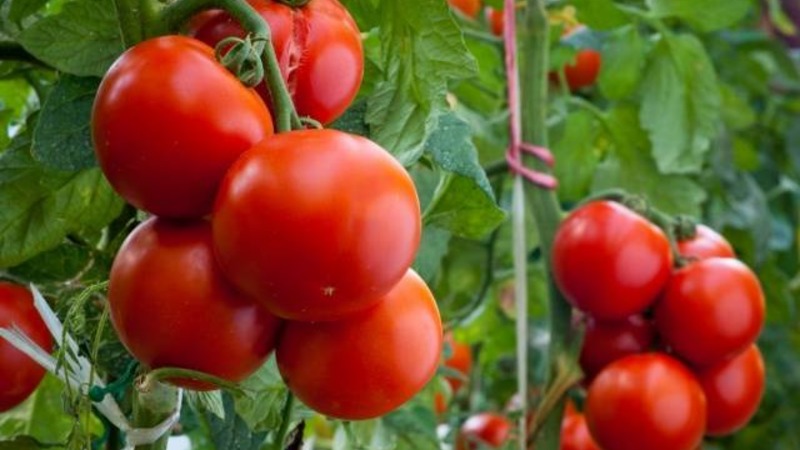
A type determinant, plant height - 60-80 cm. Sprawling bushes, dense foliage, medium-sized leaves, dark green. The first inflorescence is laid over 5-6 leaves, the subsequent ones - every 2-3 leaves.
An early ripe species, from the moment of emergence to full maturation, it takes 80-90 days.
The yield is high, from 1 sq. m, up to 11 kg of fruits are harvested, provided that 5-6 seedlings are planted per 1 sq. m.
It is characterized by increased resistance to diseases such as the tobacco mosaic virus and macrosporiosis, but it is prone to late blight, therefore it is recommended to carry out systematic prevention.
Tomato adapts well to heat and drought, but excess moisture and low temperatures are detrimental.
The culture does not need pinching despite the large number of lateral shoots, but without garters undersized bushes are indispensable. When vegetables ripen, the branches do not support their weight and break.
Fruit characteristics
The average weight of one fruit is 80-100 g, the shape is round, the color is rich red. The taste is excellent, sweet with obvious sourness, the pulp is juicy. Seed chambers 4-6. The rind is dense, not prone to cracking. Ripe vegetables are rich in vitamin C.
The purpose is universal: excellent for fresh consumption in various dishes and for winter preparations. Tomatoes are also processed into tomato products for making juices, ketchups, adjika, and pasta.
Ripe vegetables are subject to long-term storage without losing their presentation and can withstand transportation over any distance. For these reasons, entrepreneurs breed a hybrid for sale.
The photo shows Irishka tomatoes.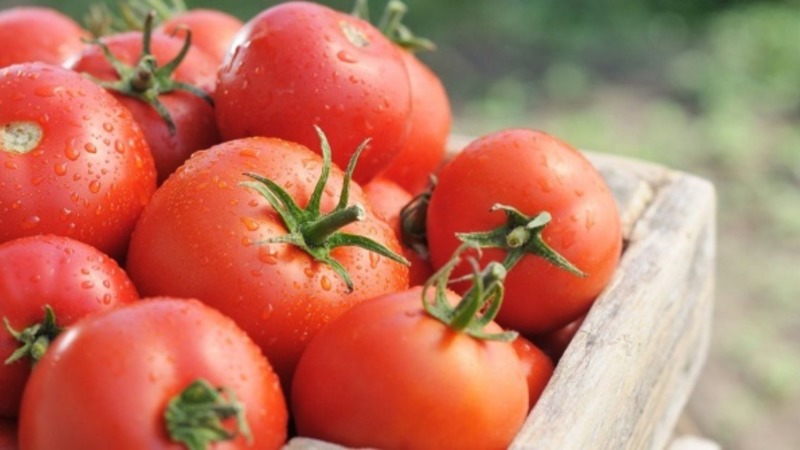
How to grow seedlings
Sowing seeds for seedlings begins 2 months before planting in the ground. Before sowing, the seeds undergo compulsory preparation.
Seed preparation
The seed is laid out on the table and carefully inspected for visible damage. Then placed in saline for 10 minutes to determine whether the seeds are empty or not.
Floated to the surface are not suitable for sowing. Then the grains are disinfected in a solution of pink potassium permanganate for 20 minutes. After disinfection, they are washed with running water and dried.
reference... After disinfection, up to 30% of the seeds lose their germination.
To improve germination, the seeds are germinated on damp gauze for 2-3 days. To do this, they are laid out on gauze, slightly moistened with warm, settled water and left in a dark place at a temperature of at least 27 ° C. As it dries, the gauze is moistened. After the sprouts appear, the seeds can be sown in the ground.
Capacity and soil
The soil is prepared from garden soil, humus and peat in equal amounts. All components are thoroughly mixed and the resulting mixture is disinfected with a hot solution of dark-colored potassium permanganate or steamed in an oven at a temperature of 50-60 ° C for at least 10 minutes.
They are planted in a common wooden box or individual plastic cups and peat pots. The planting containers are filled with the prepared soil mixture by two-thirds, small drainage holes are first made at the bottom so that excess moisture does not stagnate in the containers.
Sowing
The grains are sown into grooves to a depth of 2 cm. The distance between the seeds is left 2.5-3.5 cm. Sprinkle with peat on top, level it, slightly moisten it with warm settled water and cover the containers with a film to create a greenhouse effect. The containers are left in a bright and warm room at a temperature of 23-25 ° C. At lower temperatures, seedlings appear much later.
The film is periodically removed for ventilation and the soil is slightly moistened as it dries.
Seedling care
When shoots appear, the containers are rearranged to a more illuminated place, on the windowsill. As the top layer of the soil dries up, the seedlings are watered with warm moderate water using a shallow watering can or a tablespoon. Water it lightly, without overflowing the sprouts. An excess of moisture has a detrimental effect on young roots.
After watering, the ground is gently loosened with a wooden stick or ordinary fork. Loosening contributes to the saturation of the soil with oxygen.
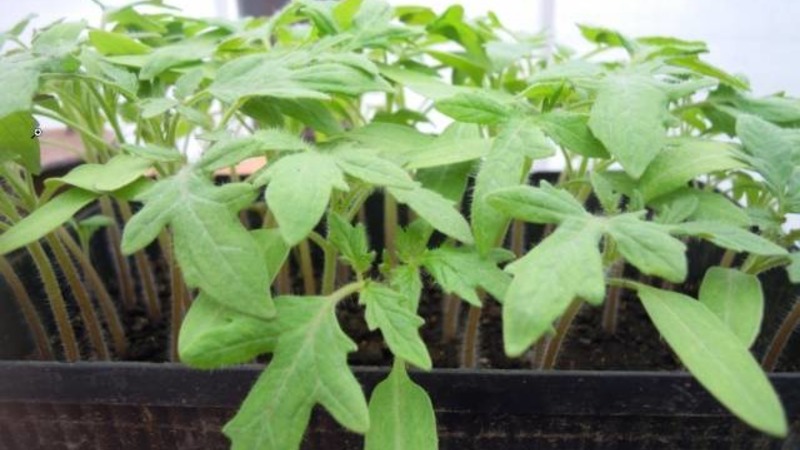 When 2-3 true leaves appear, the seedlings dive, seating them in separate containers. During the pick, weak bushes are utilized, leaving only strong and healthy ones for further growth.
When 2-3 true leaves appear, the seedlings dive, seating them in separate containers. During the pick, weak bushes are utilized, leaving only strong and healthy ones for further growth.
reference... When sowing seeds in peat pots, picking seedlings is not required. In addition, the walls of peat containers contain many useful substances, which additionally feed young roots.
During the picking period, the seedlings are fed with liquid fertilizer for tomatoes. This first top dressing is most important for weakened bushes.
2-3 weeks before transplanting, the seedlings are hardened, taking the containers outside for 1 hour in the daytime. Gradually, the interval of time spent in the open air is increased to 12-13 hours. At the same time, the night temperature in the room is reduced to 14 ° C. The hardening procedure after transplanting helps to quickly adapt to outdoor conditions and strengthens the immunity of young plants.
How to grow tomatoes
After 2 months, the seedlings are transplanted into the ground. They are planted in a greenhouse 2 weeks earlier than in open beds. But do not forget that by the time of transplanting the soil should warm up to + 15 ... + 17 ° С.
Landing

The soil for tomatoes is prepared 2 weeks before transplanting. Too dense soil is loosened with low-lying peat or river sand. Then the earth is dug up with the introduction of mineral fertilizers or wood ash.
reference... Low-lying peat contains a large amount of nutrients, due to which it improves the structure of the soil, saturating it with organic matter.
Planting scheme: 40 cm - distance between seedlings, 60-65 cm - distance between rows. For 1 sq. m place no more than 6 plants. Wide aisles are left for regular airing of the bushes and sufficient sunlight.
Transplant seedlings into holes 20 cm deep... After planting, the holes are poured abundantly with warm, settled water, compacted and the bushes are left for 1 week to get used to the new place. The best time for a transplant is early morning or evening after sunset.
Further care
Regular watering set as you adapt, but no more than 2 times a week. On dry and hot days, the amount of watering is increased up to 3 times a week. Watered with warm water, strictly at the root, without touching the leaves, in the evening or early in the morning.
Attention! When watering during the day, plant leaves can get burned.
After watering, the soil is loosened, hilled up and weeds with roots are removed. To retain moisture in the soil, the beds are mulched with straw. Weeds are also used as mulch, which, when rotting, provides the root system with additional nutrients.
For the entire season, the culture is fed three times. The first top dressing make 2 weeks after transplantation. They are fed with organic matter or nitrogenous complexes. An infusion of mullein or bird droppings in a ratio of 1:15 is used as organic matter.
The second time they feed during flowering with mineral fertilizers containing mainly potassium and phosphorus.
The third dressing is applied during the fruiting period. The fertilizer is the same top dressing that was fertilized during the flowering period: a full complex of minerals with an emphasis on potassium and phosphorus.
Features in care and possible difficulties
Plants do not need compulsory pinching, although many gardeners prefer to remove all excess shoots to the first brush. This technique reduces yields, but protects against the spread of pathogenic fungi. In addition, the removal of unnecessary shoots provides better ventilation of the bushes.
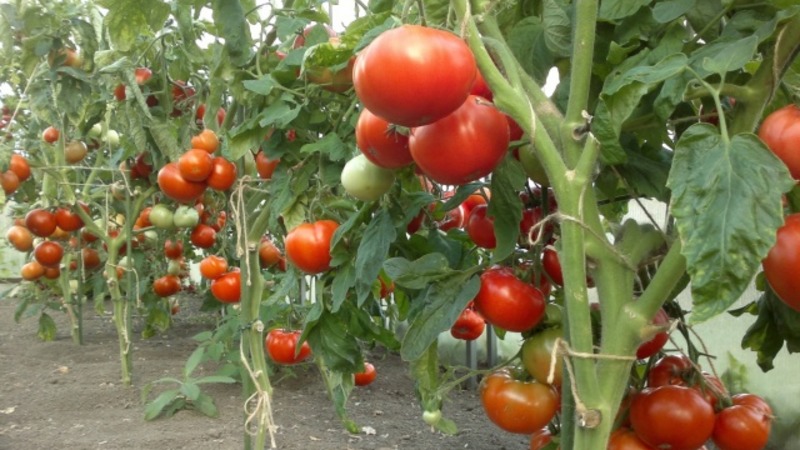 As for the garter, opinions differ here: some consider the procedure mandatory, others ignore. The fact is that in different regions the bushes reach unequal heights, and with a growth of no higher than 50 cm, the plant really does not need fixation. However, it is necessary to have additional supports on hand in case the fruiting branches cannot support the weight of ripe fruits and begin to break.
As for the garter, opinions differ here: some consider the procedure mandatory, others ignore. The fact is that in different regions the bushes reach unequal heights, and with a growth of no higher than 50 cm, the plant really does not need fixation. However, it is necessary to have additional supports on hand in case the fruiting branches cannot support the weight of ripe fruits and begin to break.
For a garter, a wooden or metal support is installed next to each bush, to which the fruitful branches are fixed as they grow.
Diseases and pests
The culture is resistant to powdery mildew, tobacco mosaic virus and macrosporiosis, but it has no immunity to late blight. Late blight Is a dangerous fungal disease that often affects the nightshade family and can kill up to 75% of plantings. Therefore, for those crops that are not endowed with persistent resistance to late blight, it is most important and necessary to carry out appropriate preventive measures.
Preventive measures include loosening the soil, mulching the beds, moderate watering with control over the state of moisture and regular ventilation of closed structures. Also, several times per season, plants are treated with fungicides, since these drugs reduce the risk of developing diseases. The most common drugs used to prevent late blight are Fitosporin and copper sulfate.
If the hybrid is planted in a greenhouse, the top layer of the soil is first replaced, disinfecting the new soil without fail. It is in the upper layer that pathogens and many pest larvae overwinter, which in spring begin to multiply successfully. A dark-colored potassium permanganate solution is used as a disinfectant.
If, nevertheless, the fungus has infected the plants, the drug "Hom" is used in the fight against it. The solution is prepared from 40 g of the product and 10 liters of water.
Important! Together with tomatoes, potatoes are also processed, since it is he who causes the disease of tomato bushes, especially when planted nearby.
Of the pests for tomatoes, aphids, Colorado potato beetle and whitefly are dangerous. A soap solution, which is used to treat the stems of affected plants, will help get rid of aphids. With a large accumulation of it, they are treated with insecticides "Decis" and "Karate".
The drug Prestige is effective against the Colorado potato beetle, and pheromone traps are installed for the whitefly butterfly.
Nuances for open ground and greenhouses
The Irishka f1 hybrid is recommended for breeding in the North Caucasian district and Central regions. As a rule, in the open field the taste characteristics are preserved exactly as declared by the manufacturer. However, tomatoes are also grown in cold regions in greenhouse conditions. According to the characteristics and reviews of gardeners, the taste of ripe tomatoes is noticeably different from the southern ones.
 The earth is best prepared in autumn, fertilizing with organic matter and superphosphate. So it is better saturated with useful substances, which affects its fertility. Planting sites are chosen sunny, protected from drafts and, if possible, elevated.
The earth is best prepared in autumn, fertilizing with organic matter and superphosphate. So it is better saturated with useful substances, which affects its fertility. Planting sites are chosen sunny, protected from drafts and, if possible, elevated.
It is not necessary to form a hybrid. Many gardeners pick off all stepchildren, thereby accelerating the ripening of the fruit. But at the same time, this method leads to a decrease in yield. Usually this is done when there is a real threat of late blight.
Planting conditions depend on the region where the crop is grown. In the southern area, 1 sq. m place 6 seedlings, in the middle lane - no more than 5.
Harvesting and application of the crop
Vegetables ripen at the same time, so you should prepare a container for harvesting in advance. Overripe tomatoes should not be allowed, it is better to pick them unripe. Tomatoes will color on their own at room temperature.
The purpose of ripe vegetables is universal. They are eaten fresh, making a variety of salads, first and second courses. They are baked with meat and fried with eggs, and allowed to make pizza.
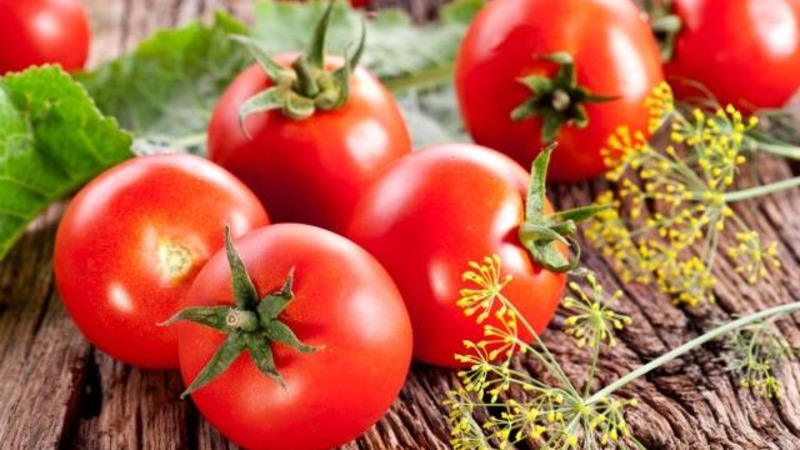
Small tomatoes are great for canning whole fruits, pickles and pickles. They do not lose their taste in tomato products: they make excellent juices, pastes, adjika and ketchups.
Ripe vegetables are stored for a long time and can withstand long-term transportation without losing their presentation. As a result, the hybrid is grown commercially in many regions.
Advantages and disadvantages of the variety
Positive aspects of the hybrid:
- the ability to take root in all regions;
- adaptation to drought and high temperatures;
- unpretentious care;
- early ripening;
- does not require pinning;
- high rate of fruiting;
- great fruit taste;
- amicable maturation;
- high commercial quality;
- long-term storage;
- long transportation;
- versatility in cooking.
The disadvantages include:
- susceptibility to late blight;
- fear of low temperatures;
- impossibility of self-procurement of seeds for planting.
Farmers reviews

Many gardeners admit that they decided to plant a hybrid after the photos they saw, which do not exaggerate the brilliance of ripe fruits. In most cases, gardeners opt for the Irishka hybrid, refusing to experiment with other species.
Victoria, Irkutsk: “I planted seedlings in the ground at the end of May, and they took root well. A lot of tomatoes were tied, so the bushes had to be strengthened with supports. We collected the harvest until mid-September - all the fruits are round, even, about the same size. I really liked the taste of the tomatoes, especially in the seaming. I will definitely plant more! "
Ivan, Vladimir region: “I planted a hybrid in a greenhouse. The bushes grew up to 50 cm, did not tie, did not pinch. A very good harvest. The vegetables are sweet, sour, ideal for pickling. The dimensions are just right for a can. "
Conclusion
Irishka tomato has long been known both in Russia and in the countries of the Near Abroad. This hybrid with excellent characteristics has conquered many regions, having managed to adapt to various climatic conditions.
The high fruiting rate and ease of care are complemented by the excellent taste of ripe tomatoes that can decorate any table not only in fresh salads, but in winter preparations.